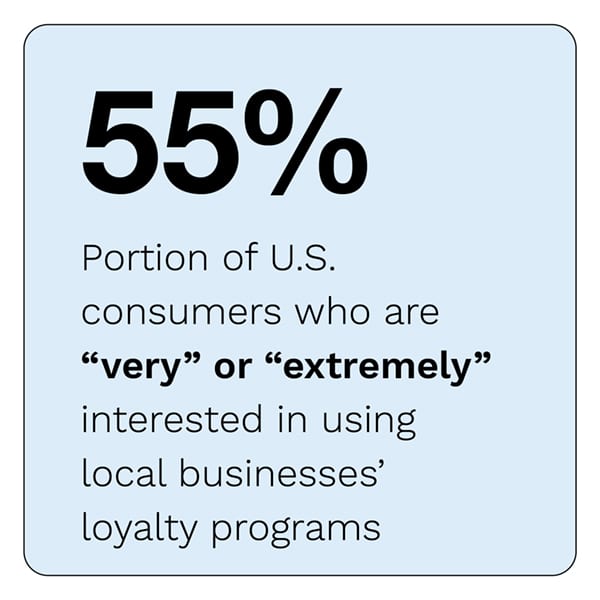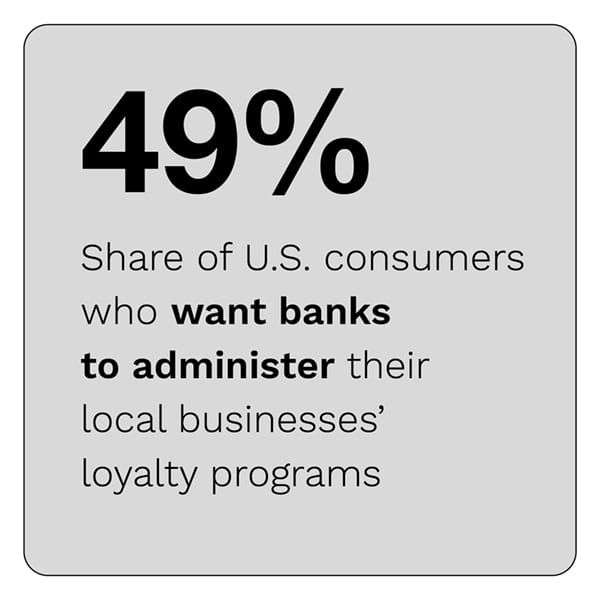NEW DATA: Bank-Powered Loyalty Programs Could Help US Main Street Businesses Win 139M Customers

 Small businesses may be the backbone of the United States economy, but one might not know it from looking at U.S. consumers’ shopping habits.
Small businesses may be the backbone of the United States economy, but one might not know it from looking at U.S. consumers’ shopping habits.
American consumers are far less likely to shop with the mom-and-pop stores on Main Street than they are to purchase from mass merchants and national chain stores like Walmart, Costco and Target. This is despite the fact that 39 percent of them see local commerce as “very” or “extremely” important and that 47 percent see it as even more crucial than it was before March 2020.
 Loyalty programs just might be the key to closing the gap between consumers’ interest in shopping with local businesses and their doing so in practice. Programs that provide customers with rewards and other special offers can help Main Street businesses drive more foot traffic. There are roughly 139 million U.S. consumers who would like to use services that reward them when they shop with local businesses. The trick to capitalizing on this opportunity is providing rewards and special offerings that deliver on U.S. shoppers’ expectations.
Loyalty programs just might be the key to closing the gap between consumers’ interest in shopping with local businesses and their doing so in practice. Programs that provide customers with rewards and other special offers can help Main Street businesses drive more foot traffic. There are roughly 139 million U.S. consumers who would like to use services that reward them when they shop with local businesses. The trick to capitalizing on this opportunity is providing rewards and special offerings that deliver on U.S. shoppers’ expectations.
The Making Loyalty Work For Small Businesses: United States Edition, a PYMNTS and Pollinate collaboration, examines how the businesses on Main Street USA can use loyalty programs and other special offerings to rebuild as the economy continues to reopen. We surveyed a census-balanced panel of 1,247 U.S. consumers as part of our broader research into the shopping habits and loyalty program usage of 4,519 consumers across Australia, Brazil, the United Kingdom and the U.S. to find out how Americans stand out from the rest — and how local businesses can tailor their loyalty programs to customers’ unique needs and expectations.
Loyalty and rewards programs represent a massive growth opportunity for Main Street businesses, but there is a catch: Most U.S. consumers would not trust these businesses to handle
 their user data. This data is needed to provide the personalized rewards programs that consumers want, as it helps businesses ascertain their individual shopping needs and preferences. Only 8 percent of consumers in the U.S. say they would trust local businesses to collect, store and manage it, however. This lack of trust can dissuade shoppers from signing up for the programs they want and dampen any impact they might have on businesses’ foot traffic.
their user data. This data is needed to provide the personalized rewards programs that consumers want, as it helps businesses ascertain their individual shopping needs and preferences. Only 8 percent of consumers in the U.S. say they would trust local businesses to collect, store and manage it, however. This lack of trust can dissuade shoppers from signing up for the programs they want and dampen any impact they might have on businesses’ foot traffic.
Luckily, there is a solution. PYMMTS research shows that more than four times as many U.S. consumers would trust banks to manage their personal data as would trust small businesses to do so. Main Street businesses can therefore partner with banks and other trusted third-party providers to deliver the data-driven loyalty solutions that can boost their numbers and give them a competitive edge.
 These potential partnerships are only the first part of a far more complex story behind U.S. consumers and their relationships with local businesses, however. Making Loyalty Work For Small Businesses: United States Edition provides a rich contextual analysis of this relationship and what it means for Main Street as the U.S. economy reemerges from more than a year on hold.
These potential partnerships are only the first part of a far more complex story behind U.S. consumers and their relationships with local businesses, however. Making Loyalty Work For Small Businesses: United States Edition provides a rich contextual analysis of this relationship and what it means for Main Street as the U.S. economy reemerges from more than a year on hold.
To learn more about how Main Street USA businesses can tap loyalty programs to boost their business, download the report.